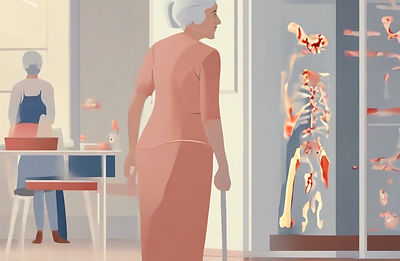Understanding Menopause and Osteoporosis: What’s The Link and What Can You Do?
Emily Bergin
January 2024
What is Osteoporosis?
Osteoporosis is a condition marked by decreased bone mass and strength, which inevitably leads to fragility and fractures.[1] It can negatively impact an individual’s physical and mental health by causing pain and reducing both mobility and independence, particularly in older adults. While this disease affects all people, it has the largest impact on women, with about 80 million women over the age of 50 in the U.S. afflicted with this disease compared to only 2 million men.[2]
Risk Factors
One reason for the higher risk for older women is because of the accelerated bone loss that occurs when women enter menopause. Estrogen is the hormone that regulates bone growth and loss and when its levels plummet during menopause, many women are at an increased risk of having brittle bones. Other risk factors outside of age and gender include genetics, smoking, and other diseases and drugs that impact bone health.[3]

Treatment
To mitigate the impact of estrogen on bone health during menopause, estrogen therapy was the first developed treatment established in the 1960s. Since then, various studies have raised concerns over the safety and efficacy of estrogen therapy, citing possible increases in heart attacks and breast cancer, making many women weary of this approach.[4]
The first line of pharmacological treatment for osteoporosis is now bisphosphonate drugs, also known as antiresorptive drugs, which work to prevent the reabsorption of bone mass during turnover, reducing overall bone loss. A second, newer line of drugs known as anabolic medications works to build new bone to increase bone density as opposed to merely preventing future loss. Many individuals tend to see benefits in bone strength and reduced fractures through using a combination of the two.[5]
Despite the increase in therapeutic options, concerns have arisen about the actual prevalence in use of these drugs. Among postmenopausal women, the use of these pharmacological solutions has been decreasing since 2007 with postmenopausal women in 2017, 61% less likely to use any osteoporosis medication compared to 2007.[6]
Other Solutions
Outside of pharmacology, there are a lot of things individuals can do to decrease their risk of osteoporosis and bone loss. Good nutrition is key, particularly maintaining a sufficient intake of vitamin D, calcium, and protein to keep up bone strength. Physical activity, especially strength training, can serve as another way to improve and maintain strong bones, reducing risks for osteoporosis and fractures.[1]
Addressing the Gap
There appears to be a large prevention and treatment gap for this group of patients, despite the high impact on both a personal and societal level. Osteoporosis has a significant impact on function and pain, affecting the individual’s ability to carry out their daily tasks, and eventually leading to a higher mortality rate. The costs to society are high as well, by increasing direct medical costs and indirect healthcare expenses through loss in productivity.[7]
Little research has been done about the true impact on the quality of life this condition can have for women. More attention and focus are essential to address the risk and gap in care for older women to ensure that they are aware of and able to reduce their risk for osteoporosis. There is a significant need to adequately inform patients, particularly women, about the benefits of these interventions, as well as the benefits of pharmaceuticals. Additional research is needed to better understand how menopause affects risks for osteoporosis and other conditions. Despite the correlation between menopause and osteoporosis, with the correct education and treatment, individuals can mitigate their concerns and keep their risk of fragility and fractures at bay.
References
[1] Lane, J. M., Russell, L., & Khan, S. N. (2000). Osteoporosis. Clinical orthopaedics and related research, (372), 139–150. https://doi.org/10.1097/00003086-200003000-00016
[2] Wright, N. C., Looker, A. C., Saag, K. G., Curtis, J. R., Delzell, E. S., Randall, S., & Dawson-Hughes, B. (2014). The recent prevalence of osteoporosis and low bone mass in the United States based on bone mineral density at the femoral neck or lumbar spine. Journal of bone and mineral research : the official journal of the American Society for Bone and Mineral Research, 29(11), 2520–2526. https://doi.org/10.1002/jbmr.2269
[3] Management of osteoporosis in postmenopausal women: the 2021 position statement of The North American Menopause Society. (2021). Menopause (New York, N.Y.), 28(9), 973–997. https://doi.org/10.1097/GME.0000000000001831
[4] Tella, S. H., & Gallagher, J. C. (2014). Prevention and treatment of postmenopausal osteoporosis. The Journal of steroid biochemistry and molecular biology, 142, 155–170. https://doi.org/10.1016/j.jsbmb.2013.09.008
[5] New York State Department of Health . (2020, June). FDA-Approved Medications for Osteoporosis Treatment. Department of Health. https://www.health.ny.gov/publications/1984/index.htm
[6] Orces C. H. (2022). Trends in osteoporosis medication use in US postmenopausal women: analysis of the National Health and Nutrition Examination Survey 1999-2000 through 2017-2018. Menopause (New York, N.Y.), 29(11), 1279–1284.
[7] Amin, U., McPartland, A., O’Sullivan, M., & Silke, C. (2023). An overview of the management of osteoporosis in the aging female population. Women’s health (London, England), 19, 17455057231176655. https://doi.org/10.1177/17455057231176655





